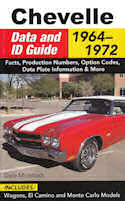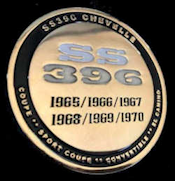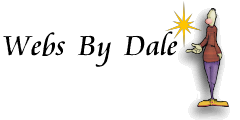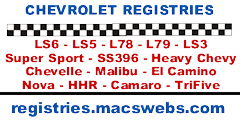|
|
|
|
|
|
|
|
|
1969 Chevelle's "SS" Equipment Features

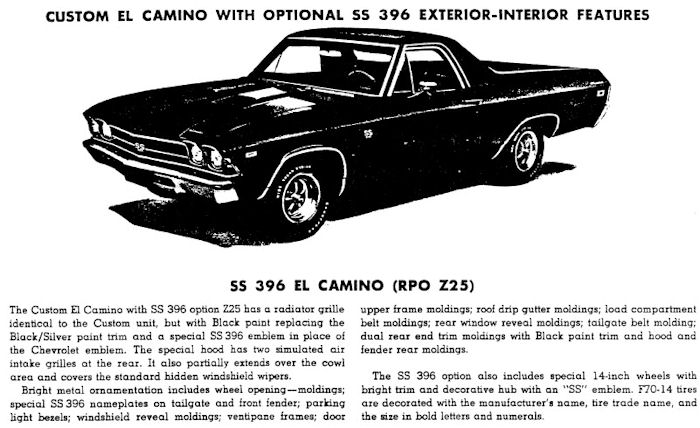
Technically, there was no SS 396 Chevelle (or Chevelle SS, Malibu SS, or whatever name one wants to use) series in 1969. In 1969 the SS 396 as a series was dropped and the 396 engine was relegated to being part of the RPO Z25, SS 396 option. Because Chevrolet promoted the Z25 SS Equipment option as an "SS 396" that term will be used here. The 1969 model year is also the ONLY year to offer any SS Equipment option on anything other than the V8 Malibu sport coupe, convertible, and El Camino. For 1969 ONLY, the Z25 option could be ordered on the V8 300 Deluxe series 2-door coupe (13427) and sport coupe (13437).
Since the SS 396 was relegated to an option and stopped being a separate series there is nothing on the Fisher Body Number plate nor the VIN to indicate the car was born with the Z25 SS 396 option with one exception. Two exterior paint colors coded "72" for Monaco/Hugger Orange and "76" for Daytona Yellow were paint choices ONLY when the SS 396 option was ordered. These two colors were certainly available on other 1969 Chevelles but did require option ZP3, special paint, to be ordered. When this was done, the trim tag would not show the "72" or "76" paint code but rather would show a dash character (-) in the appropriate lower or upper paint code position. Be alert for fake trim tags that may have one of these two paint codes added to "prove" the car is an SS. Daytona Yellow and Monaco/Hugger Orange were available on 1969 COPO Chevelles as well but those WERE NOT SS 396 optioned.
The only way to truly document a 1969 Chevelle as having the SS 396 option, aside from the two paint codes mentioned above, is with some sort of paperwork showing the option itself or the engine suffix code and the car's VIN. Examples would be the build sheet, Chassis Broadcast Copy sheet, warranty card Protect-O-Plate, or an original factory stamped engine where the partial VIN stamping is a match to the car's VIN sequence.
The 1969 SS 396 option was available with the V8 300 Deluxe 2-door coupe (13427), sport coupe (13437), V8 Malibu sport coupe (13637), convertible (13667), or pickup (13680) models and the 396 cid Mark-IV engine was the base engine. As with all years of Super Sports, the VIN only depicts the base engine and does not indicate any optional engine. The base 396 engine was the (RPO L35) 325hp engine with two optional 396 engines, the RPO L34 350hp version and a RPO L78 375hp version. Since the SS 396 option was just that, an option, the VINs on series & models that could be ordered with it simply show a V8 engine.
Contrary to popular belief bucket seats, gauges, and 4-speeds were not standard equipment. A front bench seat, no gauges (except speedometer and fuel gauge), and a 3-speed heavy duty floor-shifted transmission were standard with the RPO Z25 SS 396 option.
It has been erroneously stated in several national car magazines and online articles the 1969 SS 396 option included boxed rear lower control arms and rear sway bar under RPO F41 with the L78 engine. The F41 option was available on ANY 1969 Chevelle with the SS 396 option but were not standard on the SS equipment packages until 1970. In fact, only 722 F41 options were ordered in 1969.
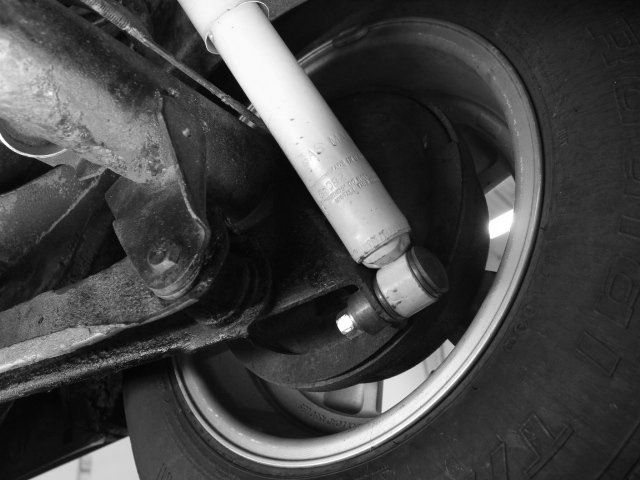
The Special Instrumentation option (RPO U14) was available on any SS-optioned Chevelle as well as any V8 Malibu sport coupe, convertible, or pickup.
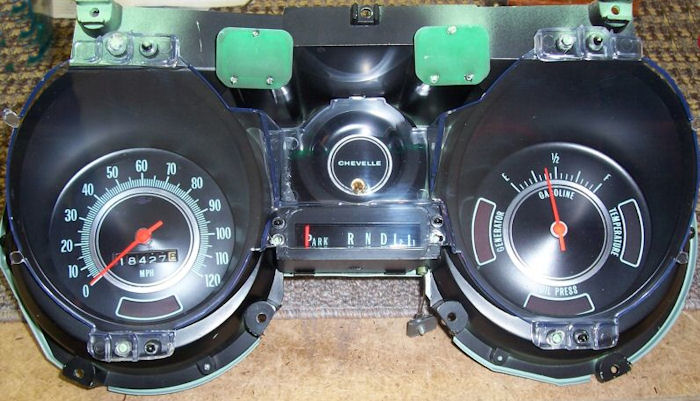
The standard instrument cluster consisted of the speedometer/odometer and fuel gauge; note warning lamps for generator, oil pressure, and water temperature. The shift pattern in the center also indicates this was a column shifted 3-speed automatic. If there is no shift pattern indicator the Chevelle would be equipped with a manual transmission or a floor shifted automatic transmission.
Three examples of the Special Instrumentation option are shown here. Note redline for tachometer is based on the engine ordered; #6469404 5500 rpm on the left (L34 & L35 396 V8) and #6469408 6000 rpm on the two below (L78 396 V8) and a 3rd redline (#6469397 5000 rpm) was used with 307, 327, and 350 V8 engines. The warning lamps for generator, oil pressure, and water temperature have been replaced with an ammeter for the battery and gauges for oil pressure and water temperature. Not shown here, but the electric clock was also part of the Special Instrumentation option and would occupy the center pod in the cluster shown above the shift pattern indicator.
Group 9.750

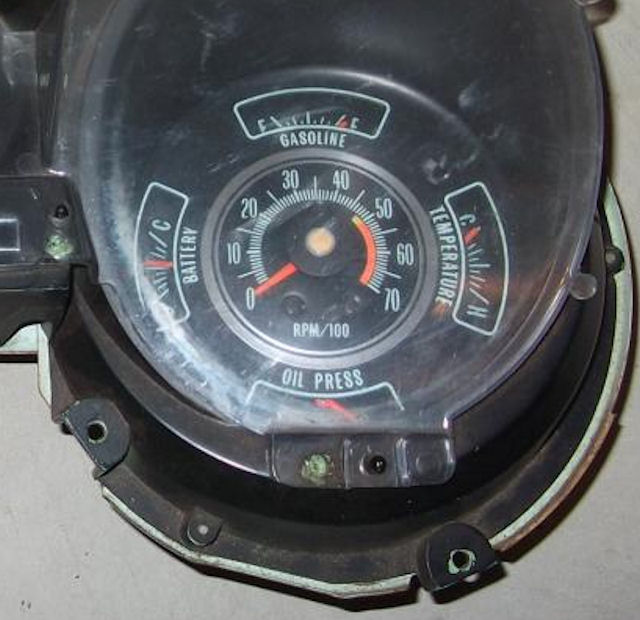
6469397 - All V8 except 396
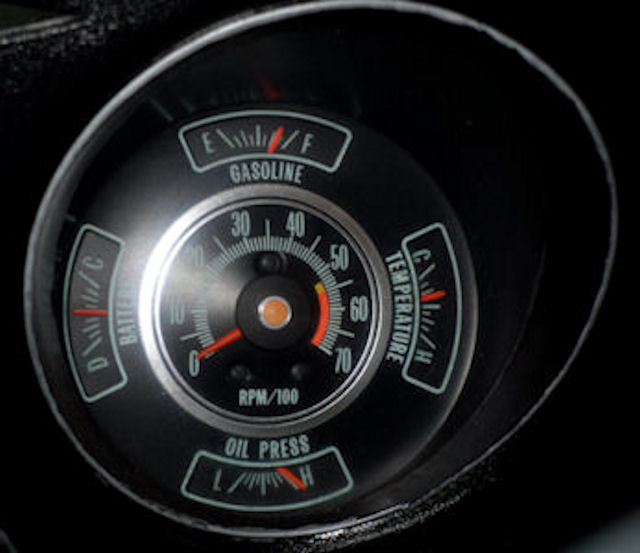
6469404 - 396 V8 325hp and 350hp
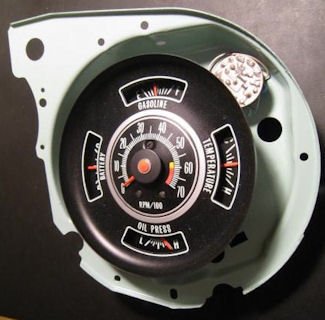

6469408 - 396 V8 375hp
Note the circuit boards on these two units. The one on the left with the circular board is an original GM unit while the one on the right with the rectangular board is an aftermarket unit. Nothing wrong with an aftermarket unit but you can see the difference.
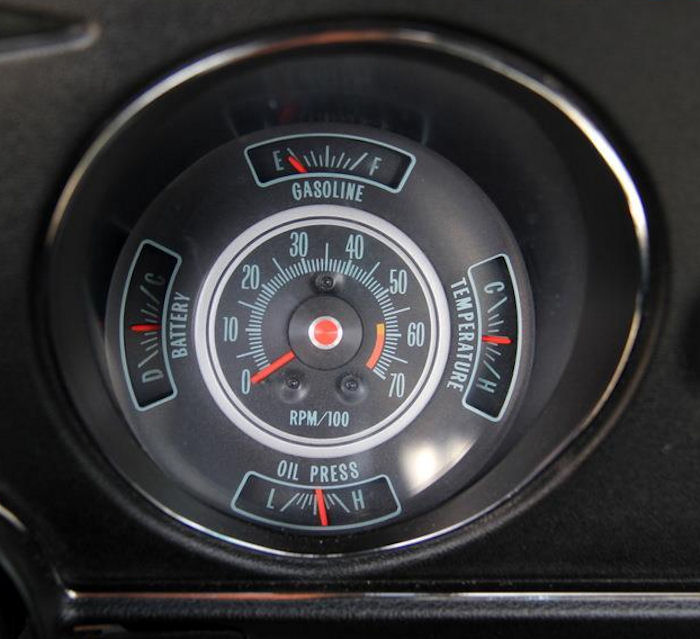

Suspect reproduction tachometer - note 5700 redline
All SS 396-optioned Chevelles came with a 12-bolt rear end but Positraction was still an option; an open rear end was standard. However, a 12-bolt rear end, as well as Positraction, was available on non-SS 396-optioned Chevelles as well so the presence of a 12-bolt (with or without Positraction) is not an indication of a 1969 SS 396-optioned Chevelle.
The RPO Z25 SS 396 option included the base 325hp, Turbo-Jet 396 V8, black-accented grille, special hood, ornamentation and suspension plus sport wheels and wide-oval tires white lettered tires, power disc brakes, and special 3-speed manual transmission. RPO D96 side stripes were optional and came in black, white, blue, or red and the stripe color were dependent on the color of the car, on in the case of a convertible or vinyl top option, the convertible's top color or sport coupe's vinyl top color and interior colors. See Exterior-Interior Combinations/Seat Belts/Stripe Colors for more details.
Power disc brakes could also be ordered on ANY non-SS optioned Chevelle so the presence of front power disc brakes is not proof a Chevelle is an SS-optioned Chevelle but, on the other hand, any Chevelle with drum brakes is not an SS-optioned Chevelles. Fuel lines are another clue, to a point. Both the L34 and L35 engines used a fuel return line so there will be two fuel lines along the frame rail. Production (non-SS) Chevelles have a single fuel line. The one exception is the optional L78 engine available with the SS option, it also only has one fuel line.
Optional transmissions included both the M20 or M21 manual 4-speed transmission or the TH400 automatic. Depending on the rated horsepower of the engine selected, the appropriate TH400 would be selected. Three different versions of the TH400 were available and can be identified by the metal tag on passenger side of the case. A "CC" coded TH400 was installed behind the base 396/325hp engine, a "CE" coded TH400 was installed behind the optional L34 396/350hp engine, and a "CX" coded TH400 was installed behind the optional L78 396/375hp engine.
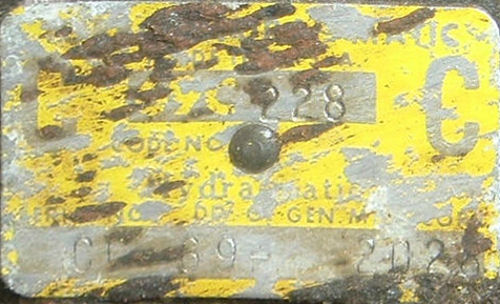
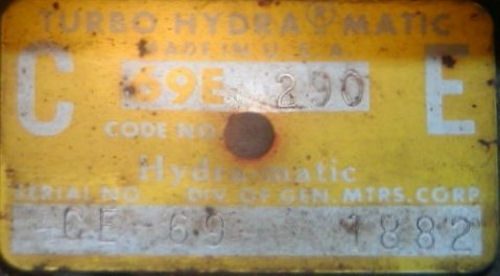

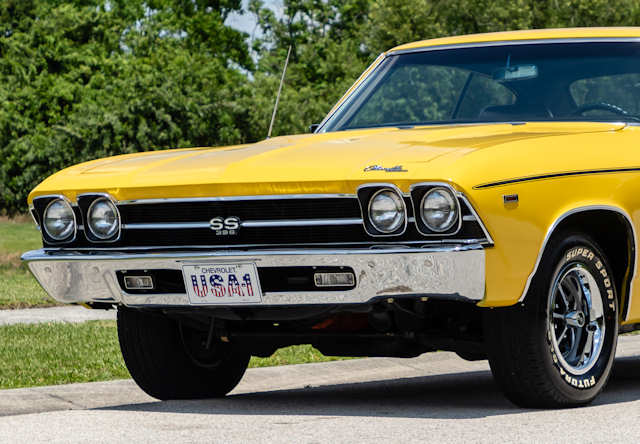
Blacked-out grille with single bright horizontal bar and SS 396 emblem
centered in the grille and SS 396 badging on the rear of the front fender.
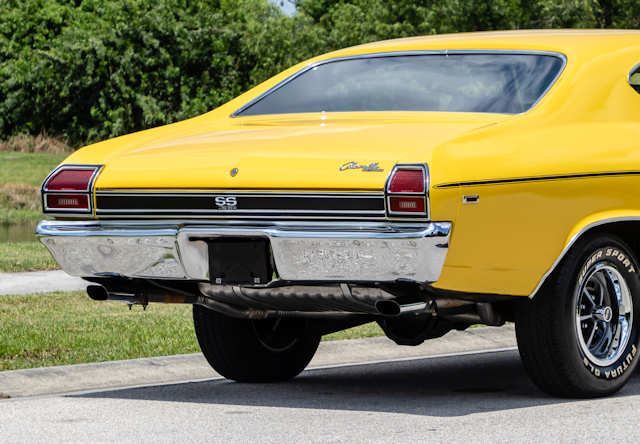
Blacked-out rear cove with SS 396 badging centered between the tail lamps.
See more about the tail lamp bezels below.

The 1969 SS 396 came standard with special 5-spoke SS wheels and shown
here with optional red stripe tires. The SS 396 option also removed the
engine size from the front side marker found on all V8 Chevelles (and
the optional 250cid L6-equipped Chevelles) and now displayed the SS 396
emblem behind the front wheels. The remaining front side marker is the
same that came with all base 230cid L6 engines.
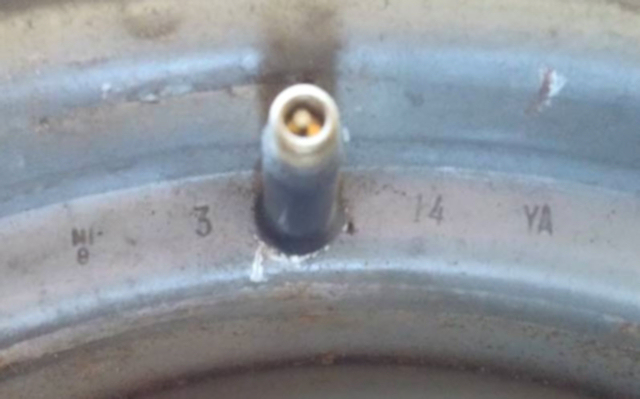
'YA' coded 1969 SS 396 SS wheel.
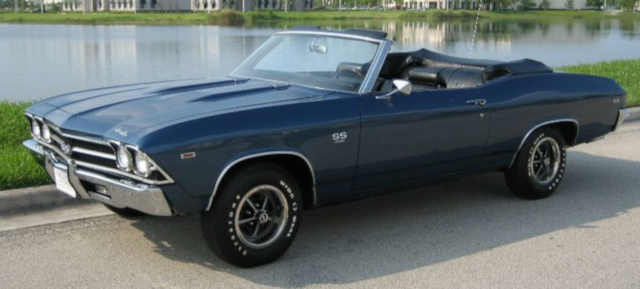
When based on the 136xx Malibu series, the lower body molding was eliminated
as part of the Z25 SS 396 Equipment option package.
Tail Lamp Housing/Cove
Another trim difference appears on the 300 Deluxe series Chevelles when ordered with the SS 396 option. This is sometimes found on build sheets as RPO T93, Deluxe Tail Lights. Just what are "Deluxe Tail Lights?" The Malibu series got these deluxe tail lights where the 300 Deluxe series did not. However, when a 300 Deluxe series coupe or sport coupe was ordered with the SS 396 option, these deluxe tail lights were included. Basically the difference is in the bezel itself as you can see from the photos.

This is a non SS-optioned 300 Deluxe. Note lack of trim in the cove
and 'plain' tail lamp bezels.

This is a 300 Deluxe coupe (13427) SS clone; note tail lamp bezels are
the same as the non SS-optioned 300 Deluxe in the above photo even though
it has the blacked out cove, SS 396 emblem and cove trim.
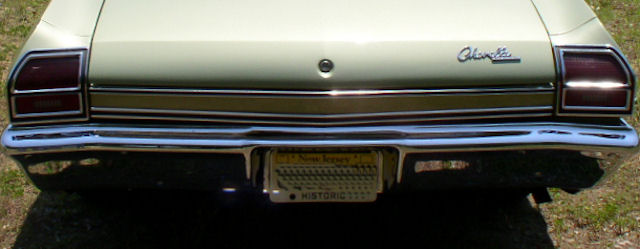
This is a non SS-optioned Malibu sport coupe.

This is SS-optioned Malibu; same tail lamps as the non SS-optioned Malibu
sport coupe above.

Finally, a true SS-optioned 300 Deluxe coupe.
»» The 1969 SS 396 optioned Chevelle would be the last year for a blacked-out tail panel. One professional restoration shop uses a basecoat clear coat to reproduce the color and sheen. "Global makes clear coat D8115 and D8117 with D8115 being flat and D8117 being a semi-gloss. How you cocktail the two together gives you different gloss levels. The gloss levels range from F1 being Flat to F5 being the semi-gloss. I choose to use the F4 formula on the rear tail pans area."
Parking Lamps
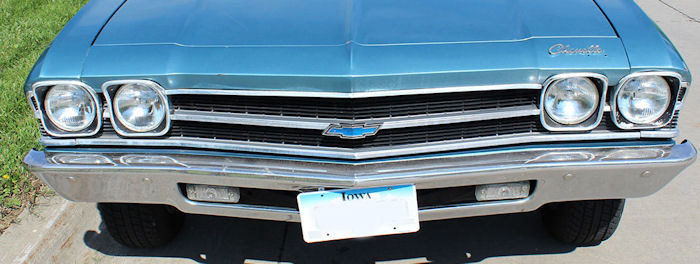
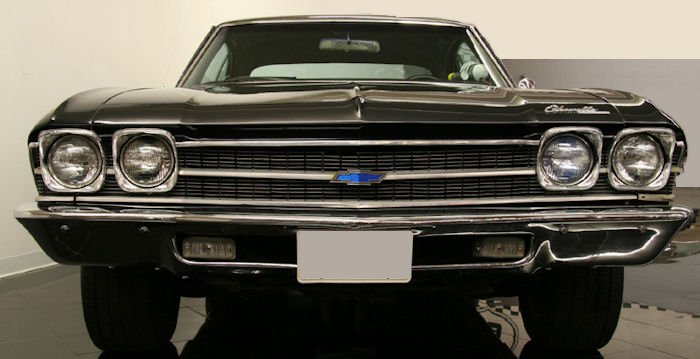
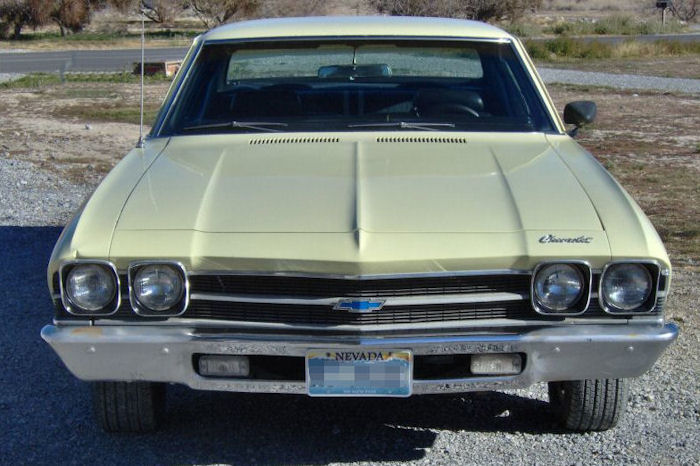
Malibu (top and middle) and 300 Deluxe coupe (bottom)
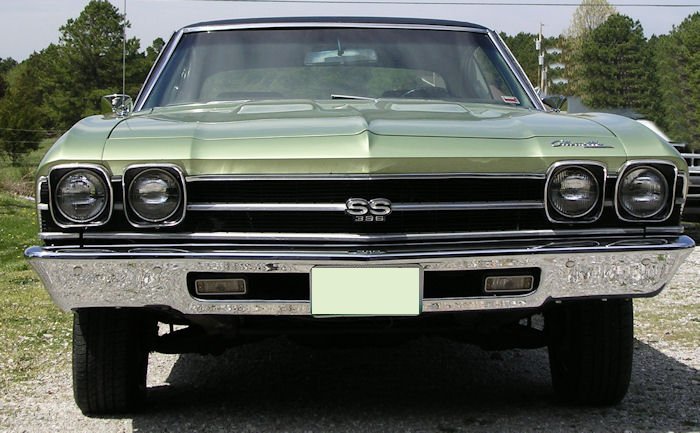
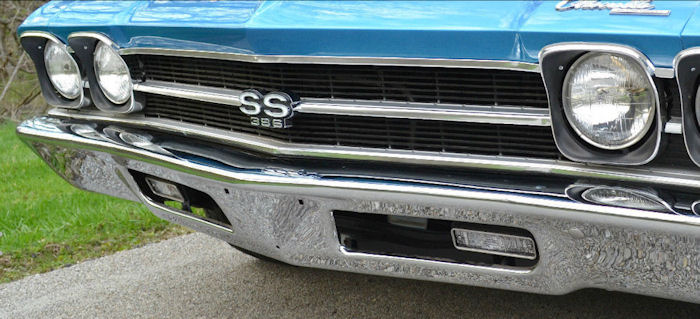
The front parking lamps are another clue. Note parking lamps on the
top two 1969 Chevelles and compare them to the parking lamps on the
bottom two 1969 Chevelles. The SS optioned Chevelles have bright
trim around the parking lamps where the non-SS Chevelles do not.
"Eyebrow" Molding
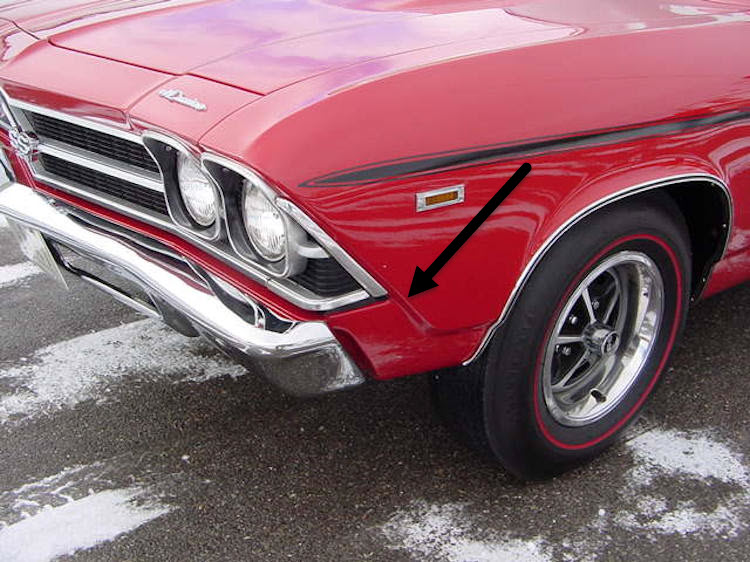
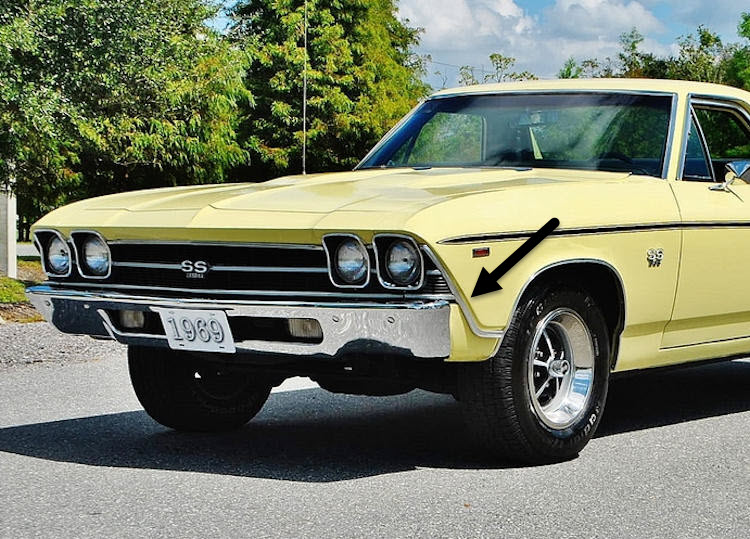
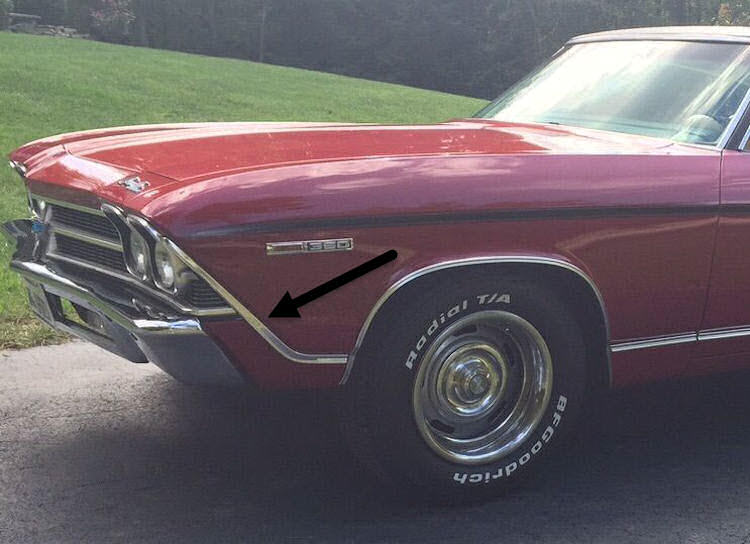
The Red El Camino is SS optioned, the Yellow El Camino is not. The headlamp "eyebrow"
trim extends to the front wheel well on non-SS optioned Malibus, be
they sport coupes, convertibles, or El Caminos where SS optioned Chevelles
stop at the bottom of the grille. The 300 Deluxe does use the same trim
here as an SS optioned Malibu (see photo below).
Grille Extensions & Filler Panel
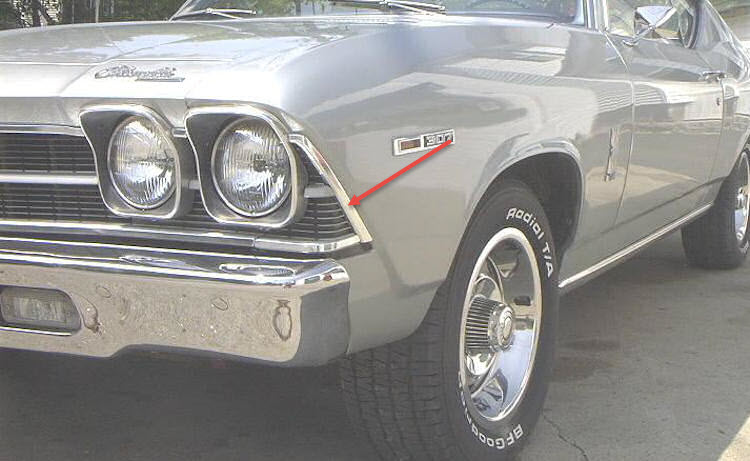
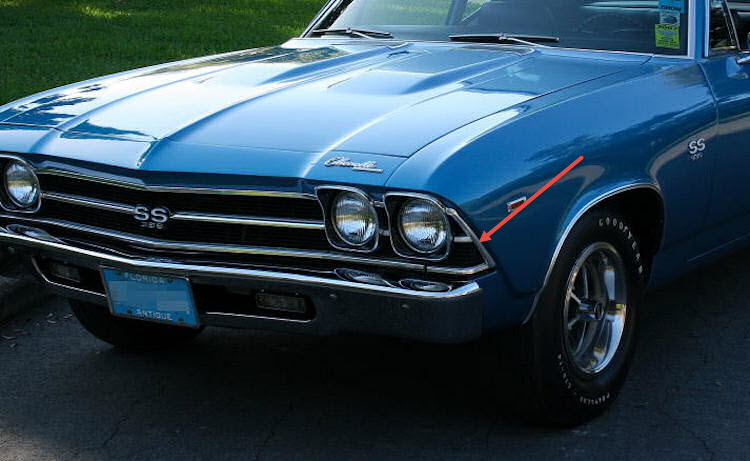


The aftermarket never seems to catch up and restorers never seem to
learn. Part of the black-out treatment with the SS option includes the
grille extensions. Top photo is a 300 Deluxe/Malibu without the SS option,
center photo is Malibu with SS option, and lower photo is Malibu with
SS option but incorrect grille extension pieces.
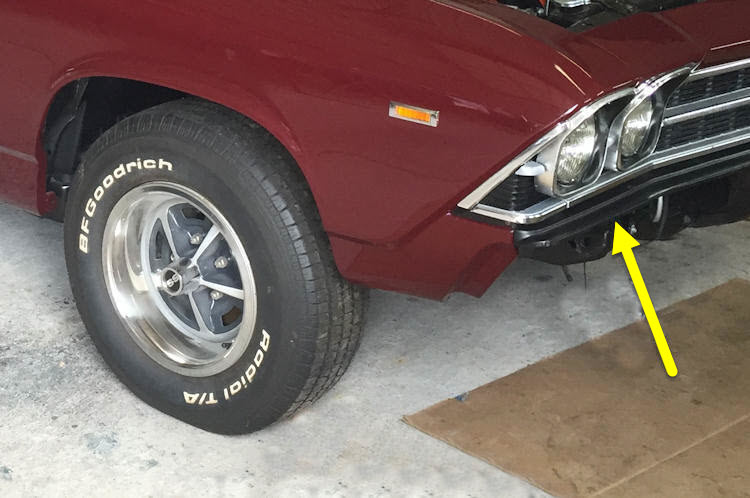
Often overlooked is the blacked-out filler panel. Photo courtesy Chad
Beeley.
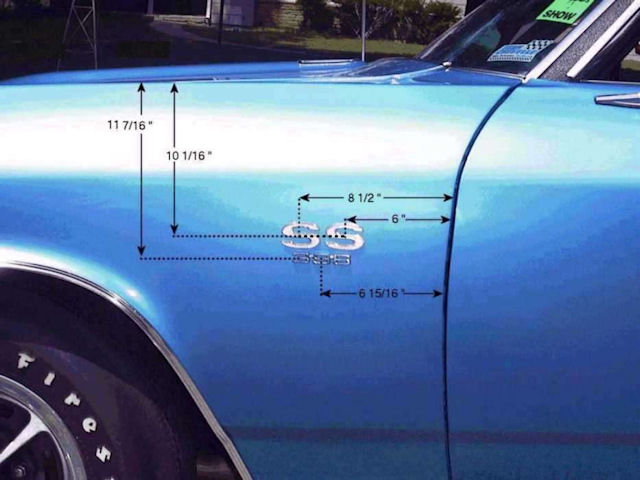
Measurements taken of SS and 396 fender emblems. Courtesy Dean Call
Canada Exceptions
Did you know that early SS optioned 1969 Malibus had M A L I B U script on the rear quarter panels?

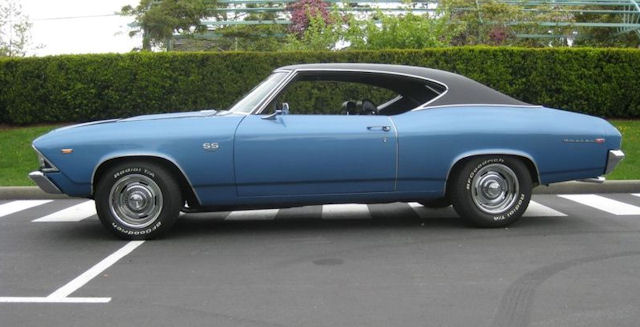
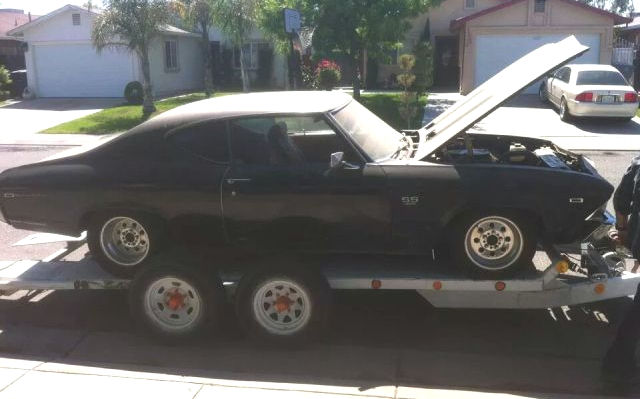

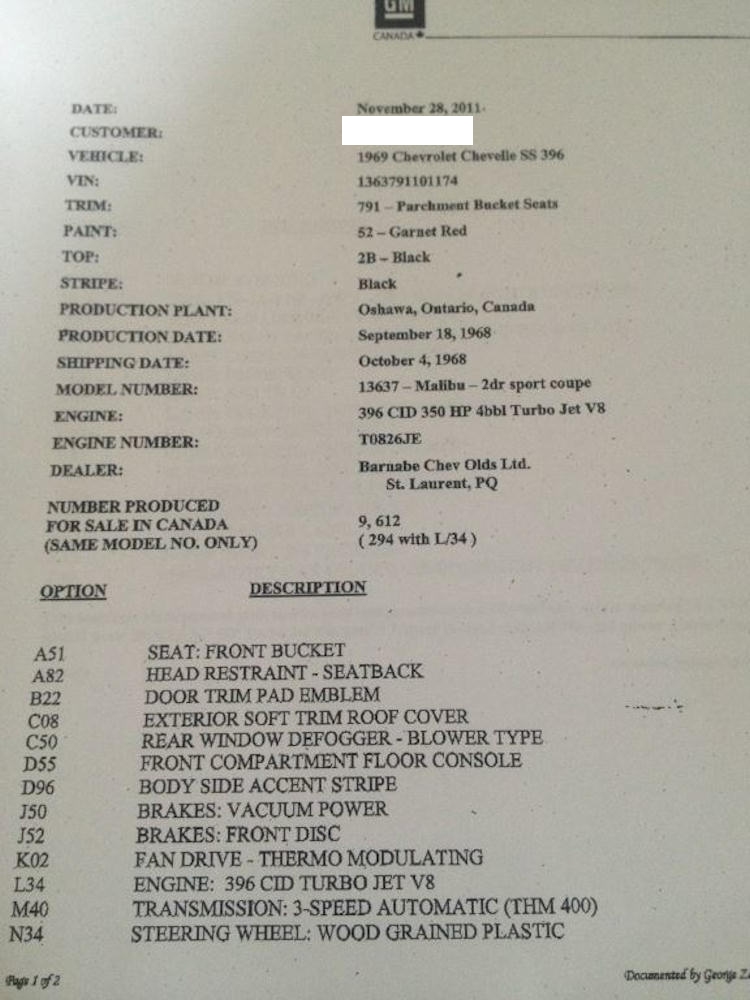
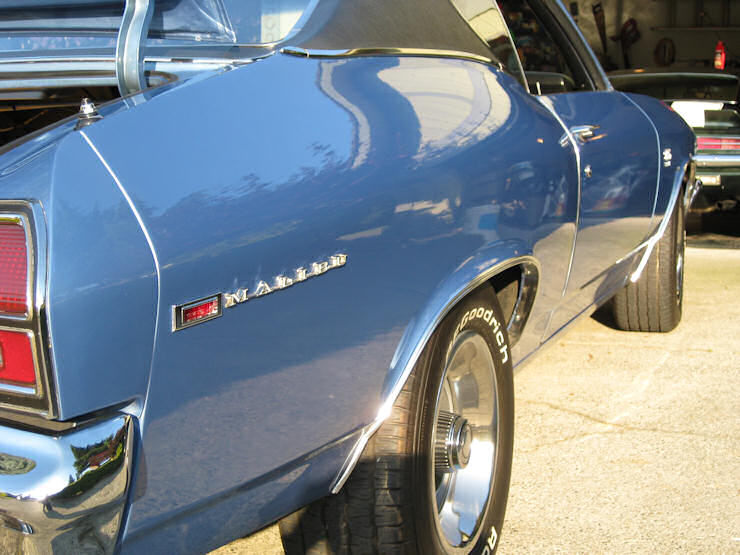
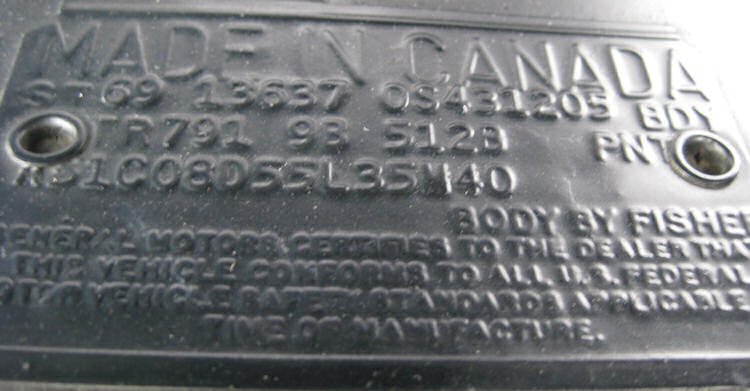
Sequence #100817
Also of interest, at least 11,323 (latest reported) 1969 Canadian Chevelles VIN sequence began with 100001. How many of these are SS optioned isn't known but the four above fit the criteria and more SS 396 optioned Chevelles in this span are known and documented. Currently the latest known shipping date is December 28, 1968.
It is often asked how many Malibu sport coupes (or any of the other 4 series/body styles) were built with the SS 396 option. Sadly those are figures we'll probably never know. One can calculate a mathematical distribution based on (1) the total number of Chevelles that could have been ordered with (2) the SS 396 option [346,406] and get a percentage of each of the 5 series/body styles since those numbers are known as well.
For example it is known that 5,620 V8 300 Deluxe coupes (13427) were sold. This represents 1.62% of the 346,406 possible Chevelles that could order the SS 396 option. Multiplying this 1.62% times the number of SS 396 options sold (86,307) results in a mathematical calculated number of 1,398. One can then mathematically calculate the number of each 396 engine based on the number of those engines. Again using the 13427 series/body style percentage of 1.62%, multiplying that percentage by the total number of L34 engines reported results in 281.
Does this really mean that 281 of the 1,398 SS 396 optioned 300 Deluxe coupes were built? No. First the 1,398 number is a calculated number based on the assumption that, indeed, 1.62% of all SS 396s were 13427 Chevelles. Second the 281 L34 engines is based on the assumed calculated number of 1,398 13427 Chevelles.
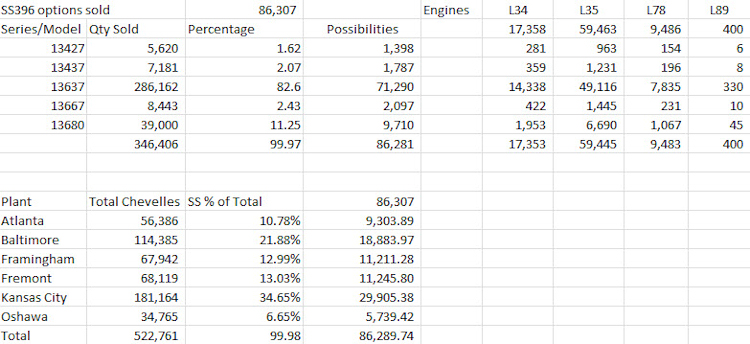
Check out my CDs and Chevelle books.
1969 Chevelle Links
- Only items in ALL CAPS and with an asterisk ( * ) are active
- PRODUCTION NUMBERS *
- Vehicle Identification Number
- Engines
- TRANSMISSIONS
- Rear Axle
- Interior Trim
- EXTERIOR PAINT *
- Interior/Exterior Combinations
- Regular Production Options
- Dealer Installed Accessories
- SS EQUIPMENT *
- Facts/Trivia
- Trim Tag Data
- PLANT PRODUCTION NUMBERS *
- TIRES & WHEELS *





